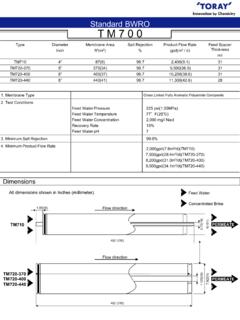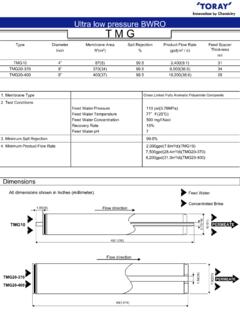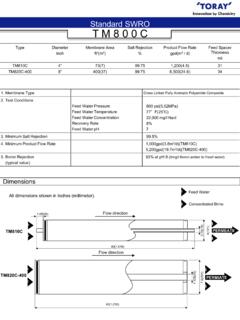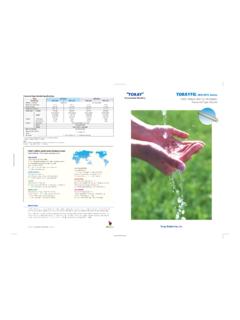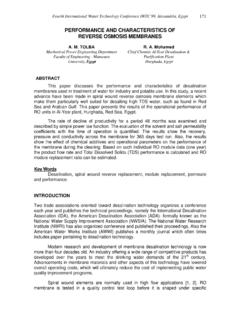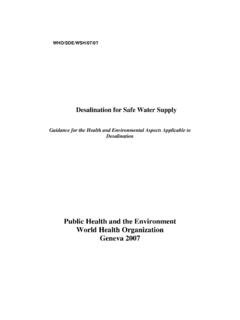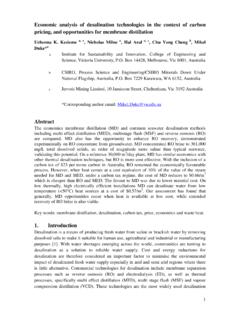Transcription of Boron removal in seawater RO desalination. - …
1 Boron removal in seawater RO desalination . Masahide Taniguchi1 , Yoshinari Fusaoka2*, Tsuyoshi Nishikawa1 and Masaru Kurihara1. Toray Industries, Inc., 1 : 2-1, Sonoyama 3-chome, Otsu, Shiga 520-0842, Japan Tel : +81-77-533-8380, Fax : +81-77-533-8695. 2 : 8-1, Mihama 1-chome, Urayasu, Chiba 279-8555, Japan Tel : +81-47-350-6030, Fax : +81-47-350-6066. Abstract In the seawater desalination field, WHO requires the Boron concentration in drinking water to be below mg/l, and this requirement has affected SWRO process design, because of the difficulty to achieve such low Boron concentration.
2 In order to overcome this problem, a new SWRO. membrane element, which had higher Boron rejecting performance, was developed. This new SWRO membrane element exhibits excellent Boron rejection performance of 94-96% with high TDS rejection and high water productivity. This new membrane element could reduce the post-treatment loading, and it could be expected the lower drinking water production cost. In order to evaluate the economical impact of the new membrane, the production cost of various SWRO systems with post-treatment processes, the BWRO at high pH condition and the Boron adsorbent resin, were estimated.
3 As a result, the cost reduction of the new SWRO membrane was estimated to up to 20 % compared to the conventional SWRO membranes, and the three-stage system, which consists of the SWRO followed by the BWRO at high pH and the Boron adsorbent resin for the BWRO concentrate, showed the most cost effective system. Keywords SWRO; Boron rejection; Boron adsorptive resin; BWRO; Post-treatment --------------------------------------- 1. Introduction ro seawater desalination processes have been focused and spreading as regular technologies to produce fresh water from the seawater , due to various advantages in the point of energy saving and less installation space.
4 Especially, the recent improvement of the performance of SWRO. membranes has enabled to obtain more fresh water at lower cost [1, 2]. In this seawater desalination field, WHO requires the Boron concentration in drinking water to be below mg/l [3], and this requirement has affected SWRO process design, because of the difficulty for SWRO to achieve such low Boron concentration [4]. In these years, the water quality produced by SWRO processes has been improved by the development of the membrane elements with higher TDS rejection [5].
5 The SWRO membrane element, designated TM820H-370, has exhibited excellent salt rejection performance, average of , and the Boron rejection of from 91 to 93 %, which are the highest levels of commercialized SWRO membranes [6, 7, 8]. This high performance SWRO membrane element series has been installed to a large number of SWRO plants shown in Table 1. However, even by such good SWRO membranes, it is still difficult to meet the WHO requirement for Boron concentration, which is below mg/l. Therefore, the mixture of other water from river or post-treatment has been required to meet the water quality requirement.
6 These days, two post-treatment processes for Boron removal have been provided to assist SWRO for Boron removal . The first process is BWRO (brackish water reverse osmosis), which can reduce Boron in the permeate, but BWRO does not have so high Boron rejection at neutral pH condition, and the alkaline should be usually dosed to raise the Boron rejection by enhancing the dissociation of Boron . This system is good from the economical point of view, but it sometimes fails to qualify the Boron regulation due to the limit of pH, which should be less than 10 or 11 for the durability of RO membranes.
7 In order to overcome this limit, an integrated system was proposed for Ashkelon by IDE Technologies [9], in which three stages BWRO processes with pH swings, for example. The second process is the Boron adsorbent, which is the resin with n-methyl glucamine as the functional group, and is provided by several chemical companies. The performance is very high but the regeneration cost is expensive, and SWRO followed by the adsorbent is cost effective system only if the loading to the adsorbent is small. Therefore, parallel process of BWRO and adsorbent was proposed, which should be the intermediate cost but more flexible for Boron reduction [7].
8 On the other hands, the high Boron removal performance has been desired on the SWRO membranes, and our recent progress has achieved to develop new high Boron rejecting SWRO membrane, which could reduce the Boron concentration in the product water and satisfy above water quality requirement with lower plant cost and lower operation cost. In this study, the cost reduction effect was evaluated considering the advanced seawater desalination system using newly developed highly Boron rejecting SWRO. membrane. 2. Development of SWRO membrane with high Boron rejection As shown in Table 2, Toray has commercialized four types of SWRO membrane elements, which are for the different pressure conditions due to the TDS concentration and temperature of the seawater .
9 Especially, SU-820 BCM is for the brine conversion two stages (BCS) process developed by Toray, which is recognized as an economically effective process [10], and a lot of BCS plants are on stage [11]. However, all listed membranes do not have enough Boron rejection performance, even they have the highest performance level in the world. As known, boric acid has ~ of pKa, and is not ionized in the natural seawater of pH. and dissociates at over pH 9 [12]. Therefore, the electric repulsive force between boric acid and the membrane, both of which are negatively charged at high pH, cannot be expected for the Boron rejection.
10 The new membrane elements were developed based on the two points of view, which were Reduction of affinity with Boron , and reinforcement of affinity with water. , and Tighter molecular structure (smaller pores) of membrane layer for the size exclusion of boric acid molecule. The potential level of new SWRO membrane composition is indicated in Fig. 1. In this figure, conventional means the variety of membranes made by the conventional methods and compositions, including SU-820, TM820H, SU-820 BCM. The new SWRO membrane group shows the higher potential (higher flux and higher Boron rejection trend) compared to conventional membranes.

